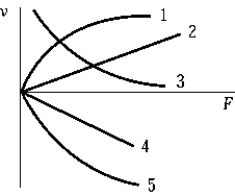An observer is standing on the platform of a railway station. A train goes through the station without stopping. If the frequency of the train whistle decreases by a factor of 1.2 as it approaches and then passes him, calculate the speed of the train (assume the speed of sound in air = 343 m/s) .
A) 112 km/hr
B) 31.2 km/hr
C) 56.0 km/hr
D) 62.0 km/hr
E) 122 km/hr
G) A) and B)
Correct Answer

verified
Correct Answer
verified
Which curve best illustrates the variation of wave velocity with tension in a vibrating string? 
A) 1
B) 2
C) 3
D) 4
E) 5
G) A) and B)
Correct Answer

verified
Correct Answer
verified